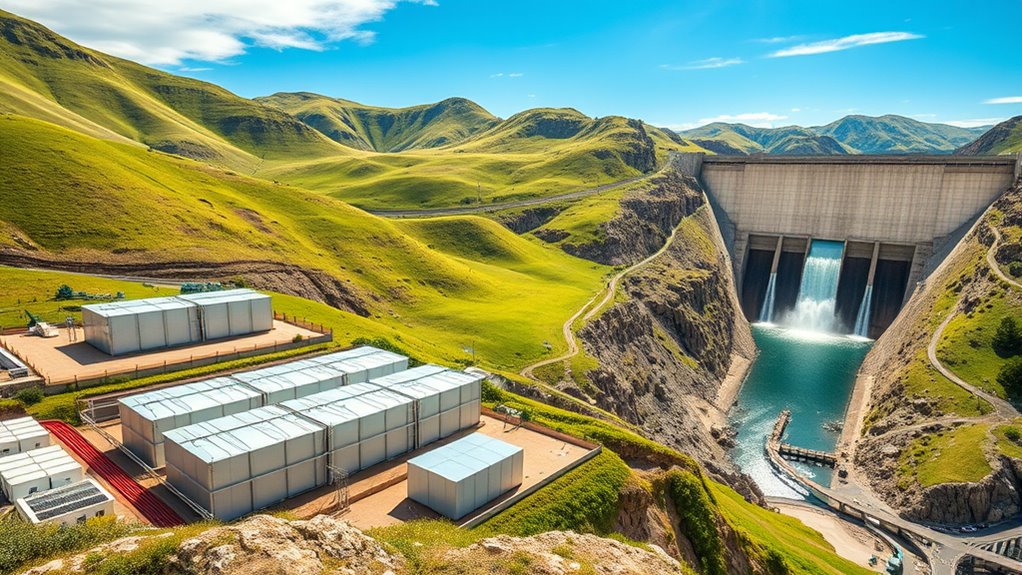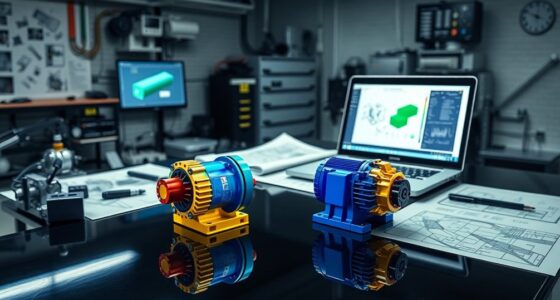Energy storage solutions like batteries, pumped hydro, and emerging technologies play a crucial role in making renewables reliable and accessible. Batteries provide fast response and high energy density for grid stability, while pumped hydro offers large-scale, long-term storage using water reservoirs. Beyond these, options like compressed air and thermal storage are gaining attention for their versatility. Continuing explores how these technologies work together to create a resilient, sustainable power system that can meet future demands.
Key Takeaways
- Batteries, especially lithium-ion, provide fast response and high energy density for grid stabilization and short-term backup.
- Pumped hydro offers large-scale, long-duration energy storage using water reservoirs and gravity principles.
- Emerging technologies like compressed air and thermal storage enhance grid flexibility and support renewable integration.
- Energy storage is vital for balancing intermittent renewable output, preventing grid overloads, and ensuring reliable power supply.
- Combining diverse storage options improves overall grid resilience, stability, and supports a sustainable energy future.

Have you ever wondered how renewable energy sources like solar and wind can be reliably integrated into our power grids? The key lies in effective energy storage solutions that facilitate grid integration and enable renewable synchronization. Without these systems, fluctuations in renewable generation could destabilize the grid, leading to outages or inefficient energy use. Energy storage acts as a buffer, capturing excess energy when supply exceeds demand and releasing it when needed. This balancing act ensures a steady, reliable power supply, smoothing out the intermittent nature of renewable sources. Batteries are among the most versatile and widely used energy storage options. They can be deployed at various scales, from small residential systems to large utility-scale projects. Lithium-ion batteries, in particular, excel in fast response times and high energy density, making them ideal for grid stabilization and short-term backup. When renewable energy production spikes, batteries absorb the surplus, preventing overloads and helping to maintain grid stability. Conversely, during periods of low generation, stored energy is dispatched to fill the gaps, ensuring continuous power supply. This process enhances renewable synchronization, allowing renewables to operate seamlessly alongside traditional power plants. This is where energy storage capacity becomes a critical factor in designing resilient energy systems. Pumped hydro storage is another prominent solution, leveraging gravity and water reservoirs to store energy efficiently. During periods of excess renewable generation, electricity is used to pump water uphill into a reservoir. When demand rises or renewable output drops, the stored water is released to flow downhill through turbines, generating electricity. Pumped hydro provides large-scale, long-duration storage, making it integral to many national grids. These large-scale systems offer reliable backup and help balance load fluctuations over extended periods. Beyond batteries and pumped hydro, emerging technologies like compressed air energy storage and thermal storage are gaining traction. Compressed air systems store energy by compressing air into underground caverns; when needed, the compressed air is heated and expanded to generate power. Thermal storage, on the other hand, captures heat produced during renewable or conventional generation, which can later be converted into electricity or used for heating. Additionally, support from reliable energy storage is crucial for maintaining grid stability and integrating more renewables. As the demand for clean energy increases, the importance of energy storage systems in preventing grid overloads and outages becomes even more vital. Investing in diverse energy storage options helps ensure the grid’s resilience and flexibility, accommodating future energy demands. Each of these solutions contributes to a resilient, flexible grid capable of accommodating increasing renewable energy shares. By investing in diverse energy storage options, you help create a power system that’s more reliable, efficient, and capable of supporting a sustainable future. The integration of these technologies is vital for renewable synchronization, ensuring renewables can fully contribute to our energy needs without compromising grid stability.
Frequently Asked Questions
What Is the Lifespan of Different Energy Storage Technologies?
You might wonder about the lifespan of various energy storage technologies. Battery chemistry influences longevity; lithium-ion batteries typically last 8-15 years with proper care, while newer chemistries like solid-state promise longer lives. Pumped hydro stations often operate for 50-100 years, making them durable. Your choice depends on your needs, but understanding these lifespans helps you plan for replacements and maintenance, ensuring reliable energy storage over time.
How Do Energy Storage Costs Compare Across Options?
When comparing costs across energy storage options, you’ll find significant differences that impact economic feasibility. Batteries tend to have higher upfront costs but offer quick deployment and scalability. Pumped hydro usually involves higher initial investments but benefits from long-term low operating costs. Understanding these cost comparisons helps you determine the most economically viable solution for your energy needs, balancing initial expenses with long-term savings and sustainability.
What Are the Environmental Impacts of Various Storage Methods?
Imagine a gentle ripple across the environment—each storage method carries its own subtle footprint. You should consider how batteries may impact resource extraction, while pumped hydro can influence ecosystems through water management. Beyond these, newer options might introduce different effects. Your choices shape the ecosystem effects and environmental footprint, so weighing these impacts helps you make more sustainable decisions for energy storage.
Can Energy Storage Solutions Support Grid Stability During Outages?
You can rely on energy storage solutions to support grid stability during outages, especially by enhancing renewable integration and microgrid resilience. When the main grid fails, these systems provide backup power, ensuring continuous electricity. This helps maintain critical services and allows renewable sources to keep contributing without interruption. By stabilizing the grid, storage solutions boost reliability and help you adapt to power disruptions effectively.
How Scalable Are Emerging Energy Storage Technologies?
You’re curious about how scalable emerging energy storage technologies are. As grid integration advances, these innovations can considerably enhance capacity and flexibility. Technological innovation drives their development, allowing for larger, more efficient systems that meet growing energy demands. While some methods like lithium-ion batteries are already scalable, others, like novel solid-state or flow batteries, are still evolving but hold great potential. Overall, these emerging solutions promise to support larger grids and cleaner energy futures.
Conclusion
Think of energy storage solutions as the backbone of a thriving power grid, holding everything together when demand spikes or sunlight fades. Batteries, pumped hydro, and other innovations act like the fuel that keeps your world running smoothly, even in the darkest moments. By embracing these technologies, you’re helping build a resilient, sustainable future—like planting seeds today for a brighter tomorrow. Stay energized and keep pushing for smarter, cleaner solutions that power your life.









